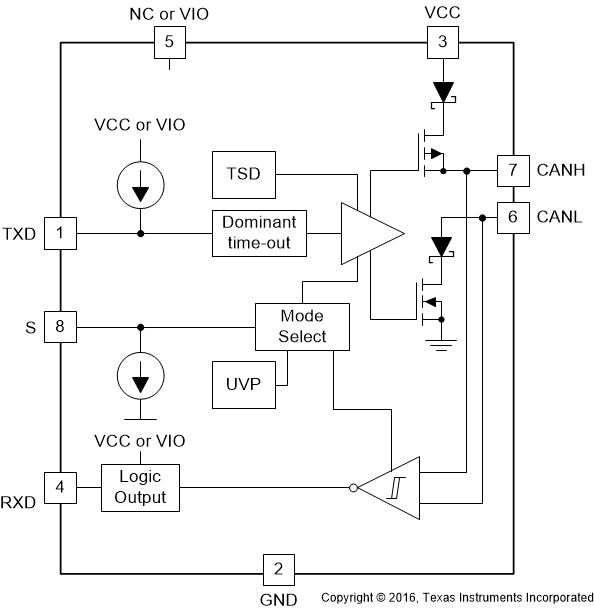-
TCAN1051-Q1Automotive Fault Protected CAN Transceiver with CAN FD SLLSET0D March 2016 – April 2021 TCAN1051-Q1 , TCAN1051G-Q1 , TCAN1051GV-Q1 , TCAN1051H-Q1 , TCAN1051HG-Q1 , TCAN1051HGV-Q1 , TCAN1051HV-Q1 , TCAN1051V-Q1
PRODUCTION DATA
-
TCAN1051-Q1Automotive Fault Protected CAN Transceiver with CAN FD
- 1 Features
- 2 Applications
- 3 Description
- 4 Revision History
- 5 Pin Configuration and Functions
- 6 Specifications
- 7 Parameter Measurement Information
-
8 Detailed Description
- 8.1 Overview
- 8.2 Functional Block Diagram
- 8.3 Feature Description
- 8.4 Device Functional Modes
- 9 Application Information Disclaimer
- 10Power Supply Recommendations
- 11Device and Documentation Support
- 12Mechanical, Packaging, and Orderable Information
- IMPORTANT NOTICE
TCAN1051-Q1Automotive Fault Protected CAN Transceiver with CAN FD
1 Features
- AEC Q100: Qualified for automotive applications
- Temperature grade 1: -40°C to 125°C, TA
- HBM classification level: ±16 kV
- CDM classification level ±1500 V
- Meets the ISO 11898-2:2016 and
ISO 11898-5:2007 physical layer standards - Functional Safety-Capable
- 'Turbo' CAN:
- All devices support classic CAN and 2 Mbps CAN FD (flexible data rate) and "G" options support 5 Mbps
- Short and symmetrical propagation delay times and fast loop times for enhanced timing margin
- Higher data rates in loaded CAN networks
- EMC performance: supports SAE J2962-2 and IEC 62228-3 (up to 500 kbps) without common mode choke
- I/O Voltage range supports 3.3 V and 5 V MCUs
- Ideal passive behavior when unpowered
- Bus and logic terminals are high impedance (no load)
- Power up/down with glitch free operation on bus and RXD output
- Protection features
- IEC ESD protection up to ±15 kV
- Bus Fault protection: ±58 V (non-H variants) and ±70 V (H variants)
- Undervoltage protection on VCC and VIO (V variants only) supply terminals
- Driver dominant time out (TXD DTO) - Data rates down to 10 kbps
- Thermal shutdown protection (TSD)
- Receiver common mode input voltage: ±30 V
- Typical loop delay: 110 ns
- Junction temperatures from –55°C to 150°C
- Available in SOIC(8) package and leadless VSON(8) Package (3.0 mm x 3.0 mm) with improved automated optical inspection (AOI) capability
2 Applications
- Automotive and Transportation
- All devices support highly loaded CAN networks
- Heavy machinery ISOBUS applications –
ISO 11783
3 Description
This CAN transceiver family meets the ISO11898-2 (2016) High Speed CAN (Controller Area Network) physical layer standard. All devices are designed for use in CAN FD networks up to 2 Mbps (megabits per second). Devices with part numbers that include the "G" suffix are designed for data rates up to 5 Mbps, and versions with the "V" have a secondary power supply input for I/O level shifting the input pin thresholds and RXD output level. This family of devices comes with silent mode which is also commonly referred to as listen-only mode. Additionally, all devices include many protection features to enhance device and network robustness.
| PART NUMBER | PACKAGE(1) | BODY SIZE |
|---|---|---|
| TCAN1051x-Q1 | SOIC (8) | 4.90 mm × 3.91 mm |
| VSON (8) | 3.00 mm x 3.00 mm |
